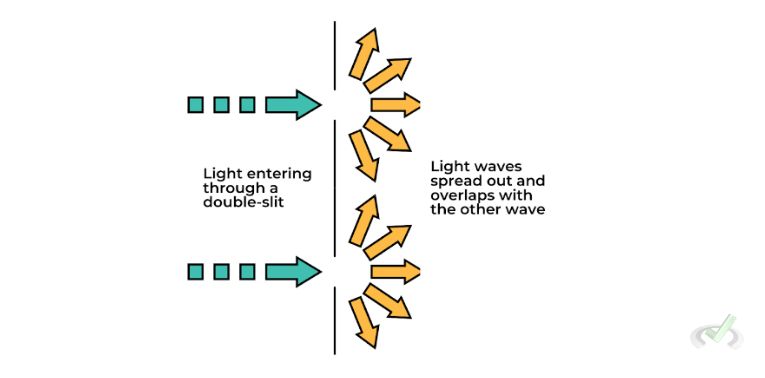As you stand at the edge of a lake, you notice how water waves spread out after it goes through a narrow gap between two rocks. This spreads out, creating ripples that travel outward. It is similar to how light behaves when it encounters obstacles or openings.
This behavior is called diffraction. It plays an important role in many scientific and technological applications. Let’s explore diffraction and slit systems in detail.
I. Introduction to Diffraction
Diffraction is the bending of light around the edges of an object or through a narrow opening. When light comes across an obstacle or a slit that is similar in size to its wavelength, it bends and spreads out. This can produce patterns of light and dark bands, known as interference patterns.

Historical Context
Francesco Maria Grimaldi first observed the concept of diffraction in the 17th century. However, Thomas Young's double-slit experiment in 1801 provided clear evidence of the wave nature of light.
In Young's experiment, light passing through two closely spaced slits produced a series of bright and dark bands on a screen. This demonstrates interference and diffraction.
II. Basics of Slit Systems
Slit systems involve using one or more narrow openings to study the behavior of light. These systems are fundamental in experiments that demonstrate diffraction and interference.
Single-Slit Diffraction
In a single-slit system, light passes through one narrow opening. This causes the light waves to spread out and interfere with each other.
This creates a pattern that alternates bright and dark bands on a screen placed behind the slit. The central band is the brightest, and the intensity of the bands decreases on either side.

Double-Slit Diffraction
A double-slit system uses two narrow, parallel slits. When light passes through these slits, it creates two sets of waves that overlap. This overlap results in an interference pattern with more distinct and numerous bands than the single-slit pattern.
The bright bands (constructive interference) occur where the waves align. Meanwhile, the dark bands (destructive interference) occur where the waves cancel each other out.

III. Factors Affecting Diffraction Patterns
Several factors influence the diffraction patterns observed in slit systems. Understanding these factors helps explain why patterns vary under different conditions.
Wavelength of Light
The wavelength of the light used significantly impacts the diffraction pattern. Longer wavelengths produce wider and more spaced-out bands. Meanwhile, shorter wavelengths result in narrower and closer bands.
Slit Width
The width of the slit also affects the diffraction pattern. Narrower slits produce more pronounced diffraction patterns, with a wider spread of light bands. Wider slits produce less noticeable diffraction patterns.
Distance Between Slits
In a double-slit system, the distance between the two slits determines the spacing of the interference bands. Closer slits create wider-spaced bands, while slits farther apart result in narrower-spaced bands.
Mathematical Explanation
The angle of diffraction (θ) can be calculated using the equation:

Where:
- d is the distance between the slits,
- λ is the wavelength of the light,
- n is the order of the maximum (1st, 2nd, etc.).
IV. Diffraction and Slit Systems in Modern Science
Understanding diffraction and slit systems connects to broader scientific ideas, enriching our knowledge of light behavior and wave phenomena.
Wave-Particle Duality
Diffraction provides evidence for light's wave nature. However, light also exhibits particle-like properties. This duality is a fundamental concept in quantum mechanics. It explores the behavior of particles at microscopic scales.
Electromagnetic Spectrum
Diffraction affects all types of electromagnetic waves, not just visible light. Through this principle, scientists can develop technologies that utilize different wavelengths, from radio waves to X-rays.
Technological Innovations
Advances in technology often stem from fundamental principles like diffraction. For example, developing advanced imaging techniques, communication technologies, and materials science can trace their roots back to basic diffraction studies.
Medical Imaging: X-ray diffraction determines the structure of complex molecules like DNA. This technique is crucial in medical diagnostics and research.
Fiber Optics: Understanding diffraction is key to developing fiber optic cables used in telecommunications. These cables transmit data as light signals over long distances with minimal loss.
Quantum Mechanics: Diffraction experiments provide insights into wave-particle duality. It is a concept important in understanding particle behavior at the quantum level.V. Wrap-Up and Key Terms
Understanding diffraction and slit systems is crucial in the field of optics. Studying how light interacts with obstacles and openings can help us create new technologies and learn about wave behavior.
Key Terms:
- Diffraction: Bending of light around the edges of an obstacle or through a narrow opening.
- Single-Slit Diffraction: Diffraction pattern created by light passing through one narrow slit.
- Double-Slit Diffraction: Interference pattern created by light passing through two narrow, parallel slits.
- Interference Pattern: Alternating bright and dark bands formed by the overlapping of light waves.
- Wavelength: Distance between successive peaks of a wave.
- Constructive Interference: When light waves align to create brighter bands.
- Destructive Interference: When light waves cancel each other out to create dark bands.
VI. Practice Questions
Sample Practice Question 1
What happens to the diffraction pattern when the wavelength of light increases?
A) The bands become narrower.
B) The bands become wider.
C) The bands stay the same.
D) The bands disappear.
Ans. B
Increasing the wavelength of light causes the diffraction pattern to spread out more, resulting in wider bands.
Sample Practice Question 2
In a double-slit experiment, what causes the bright bands in the interference pattern?
A) Destructive interference
B) Reflection
C) Constructive interference
D) Refraction
Ans. C
Bright bands are formed where the light waves from the two slits align in phase, causing constructive interference.







 To help you achieve your goal MCAT score, we take turns hosting these
To help you achieve your goal MCAT score, we take turns hosting these 





















 reviews on TrustPilot
reviews on TrustPilot